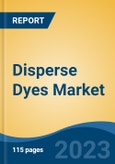Speak directly to the analyst to clarify any post sales queries you may have.
10% Free customizationThis report comes with 10% free customization, enabling you to add data that meets your specific business needs.
The growing demand for synthetic and polyester fabrics in different colour variants is expected to increase the demand for dispersed dyes from end-user industries. Apart from the textile, rising demand from leather, paint & coatings, and plastic industries are expected to propel the demand for disperse dyes. The growing demand for leather for the production of different products like shoes, clothing, purses, and belts is significantly influencing the market's growth. Hence, all the reasons mentioned above are expected to propel the demand for disperse dyes in the projected period.
Rising Demand from Automotive Industries is Propelling the Market Growth
Automotive manufacturers are installing different types of glasses and transparent fibres to lessen the weight of the vehicles. These transparent sheets allow the sunlight and UV rays inside the car and react with fabrics used in the interiors, like upholstery and floor covering of vehicles. As disperse dyes have excellent resistance to UV rays, it is demanded by manufacturers for dyeing the fabrics as they do not allow fabrics to fade after reacting with UV rays. Apart from the upholstery and floor fabrics, it is used to paint the exterior plastics surface of the vehicles and different parts of the interior, such as seat belts and airbags. According to recent studies, global commercial vehicle sales in 2021 have risen by 6.5% compared to 2020. These data indicate that there will be an increase in the demand for automobiles and related accessories. Hence, lessening the vehicle weight and providing an attractive texture that shows long-lasting performance on fabrics is going to propel the demand for disperse dye in the forecasted period.Rising Demand for Dyes for Synthetic Fibres will Propel the Market Growth
Rising uses of synthetic fibres from various sectors are expected to grow the textile, industrial, indoor, outdoor, and commercial sectors to fulfill the want of consumers, which, in-turn, will propel the dye demand. The factors such as economical price, resistance from stains, and low water absorbent make synthetic fibres a product with superior characteristics compared to natural fibres like silk, cotton, and wool. Apart from these, synthetic fibres are more durable, elastic, soft, and strong, making synthetic fibres the best raw material for the final product, such as seat belts, airbags, caps, raincoats, sportswear, ropes, and other things. According to the studies, around 62 % of the entire fibres manufactured annually are synthetic, and the majority of them are produced in China. Owing to the above-mentioned factors, it is expected that the demand for disperse dyes is going to increase in the forecast period 2028.Efforts to Develop New Products are Driving the Market Growth
Firms and institutions are developing innovative techniques to make disperse dyes more environmentally friendly. Disperse dye manufacturers have undergone some significant adjustments. Textile factories usually ensure that the dispersed dyes don't contain any artificial surfactants. There have been different research and studies going on to demonstrate a better version of disperse dyes, such as using liposomes as an additional dispersion agent that will prevent dye molecule accumulation when treated at high temperatures to enhance chances of dispersion.Recent Development
Dystar Colours Distribution GmbH (application number: CA2676212A) has a registered patent for a type of disperse dyes related to disperse azo dyes in which substituents contain specific ester groups that are associated with the chromophore. This product has excellent outstanding wash fastnesses and excellent sublimation fastnesses.Market Segmentation
Global Disperse Dyes Market is segmented based on type, chemical structure, and application. Based on type, the market is divided into low-energy dyes, medium-energy dyes, and high-energy dyes. Based on chemical structure, the market is divided into Nitro Dyes, Amino Ketone dyes, Anthraquinonoid dyes, Mono azo dyes, and Di- azo dyes. Based on application, market is divided into textile, leather, paint & coatings, plastic, and others.Market Players
Clariant International Ltd, Archroma U.S., Inc., Heubach GmbH, BASF SE, Zhejiang Lonsen Holding Co., Ltd., DIC Corporation, Mitsui Chemicals, Inc., Chevron Corporation, Huntsman Corporation, LANXESS AG are the key players operating in the global disperse dyes market.Report Scope:
In this report, global disperse dyes market has been segmented into the following categories, in addition to the industry trends, which have also been detailed below:Global Disperse Dyes Market, By Type:
- Low Energy Dyes
- Medium Energy Dyes
- High Energy Dyes
Global Disperse Dyes Market, By Chemical Structure:
- Nitro Dyes
- Amino Ketone Dyes
- Anthraquinonoid Dyes
- Mono Azo Dyes
- Di- Azo Dyes
Global Disperse Dyes Market, By Application:
- Textile
- Leather
- Paint and Coatings
- Plastic
- Others
Global Disperse Dyes Market, By Region:
- North America
- United States
- Canada
- Mexico
- Europe & CIS
- Germany
- France
- United Kingdom
- Spain
- Italy
- Asia-Pacific
- China
- India
- Malaysia
- Australia
- Japan
- South America
- Brazil
- Argentina
- Colombia
- Middle East & Africa
- South Africa
- Saudi Arabia
- UAE
- Qatar
- Egypt
Competitive Landscape
Company Profiles: Detailed analysis of the major companies present in global Disperse Dyes Market.Available Customizations:
With the given market data, the publisher offers customizations according to a company’s specific needs.This product will be delivered within 1-3 business days.
Table of Contents
Companies Mentioned
- Clariant International Ltd
- Archroma U.S., Inc.
- Heubach GmbH
- BASF SE
- Zhejiang Lonsen Holding Co., Ltd.
- DIC Corporation
- Mitsui Chemicals, Inc.
- Chevron Corporation
- Huntsman Corporation
- LANXESS AG








